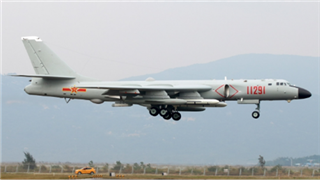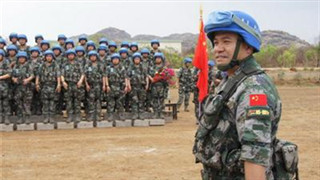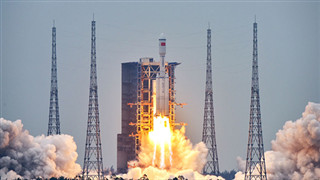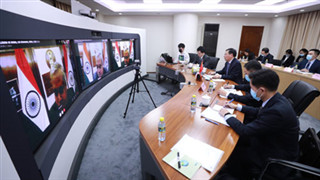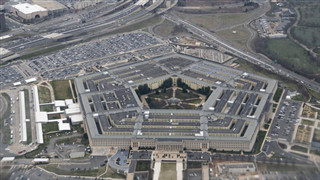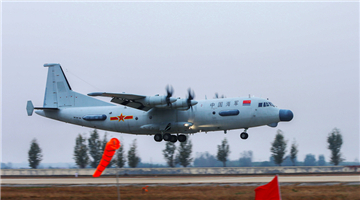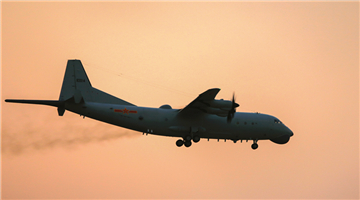三、凝聚抗击疫情的强大力量
III. Assembling a Powerful Force to Beat the Virus
面对未知病毒突然袭击,中国坚持人民至上、生命至上,举全国之力,快速有效调动全国资源和力量,不惜一切代价维护人民生命安全和身体健康。中国共产党以人民为中心的执政理念,中国集中力量办大事的制度特点,改革开放40多年来特别是中共十八大以来积累的雄厚综合国力和国家治理现代化建设的显著成效,中华民族同舟共济、守望相助的文化底色,中国人民深厚的家国情怀、天下情怀,汇聚成抗击疫情的强大合力。
Facing the sudden onslaught of a previously unknown virus, China has put the people's interests first – nothing is more precious than people's lives. It has rapidly mobilized the manpower and resources of the whole nation and done everything possible to protect the lives and health of its people. A powerful synergy has been formed thanks to the following factors: observing the people-centered governance philosophy of the CPC; China's ability to mobilize resources to accomplish major initiatives; its composite national strength built up during more than four decades of reform and opening up, particularly since the 18th CPC National Congress held in November 2012; remarkable achievements in modernizing governance; two defining values of Chinese culture – solidarity and mutual assistance; and the profound love of the Chinese people for their family and their country.
(一)人的生命高于一切
1. Lives Are Precious
在新冠肺炎疫情突袭,人民生命安全和身体健康受到严重威胁的重大时刻,中国共产党和中国政府始终以对人民负责、对生命负责的鲜明态度,准确分析和把握形势,既多方考量、慎之又慎,又及时出手、坚决果敢,以非常之举应对非常之事,全力保障人民生命权、健康权。
At a critical time when people's lives and health were endangered, the CPC and the Chinese government acted with a keen sense of responsibility and swiftly identified the problem. The central authorities took multiple factors into consideration, made timely and resolute decisions, employed extraordinary measures to deal with an extraordinary emergency, and made every effort to safeguard people's lives and health.
在人民生命和经济利益之间果断抉择生命至上。疫情暴发后,以宁可一段时间内经济下滑甚至短期“停摆”,也要对人民生命安全和身体健康负责的巨大勇气,对湖北省和武汉市果断采取史无前例的全面严格管控措施。同时,在全国范围内严控人员流动,延长春节假期,停止人员聚集性活动,决定全国企业和学校延期开工开学,迅速遏制疫情的传播蔓延,避免更多人受到感染。英国《柳叶刀》社论认为,“中国的成功也伴随着巨大的社会和经济代价,中国必须做出艰难的决定,从而在国民健康与经济保护之间获得最佳平衡”。
在疫情防控的关键阶段,准确把握疫情形势变化,作出统筹推进疫情防控和经济社会发展的重大决策,有序恢复生产生活秩序,推动落实分区分级精准复工复产,最大限度保障民生和人民正常生产生活。随着本土疫情防控取得重大战略成果,及时采取“外防输入、内防反弹”的防控策略,坚决防止来之不易的持续向好形势发生逆转,坚决防止人民生命安全再次面临病毒威胁。
Placing people's lives above economic growth. When the novel coronavirus struck, China decided that it would protect the lives and health of its people even at the cost of a short-term economic downturn and even a temporary shutdown. The government took strict and comprehensive control measures, never tried before, in the city of Wuhan and Hubei Province. To stem the spread of the virus, the movement of people across the country was tightly restricted, the Chinese New Year holiday was extended, gatherings were stopped, and the spring semester and business operations were postponed. In an editorial,The Lancetstated: "China's success has come with huge social and economic costs, and China must make difficult decisions to achieve an optimal balance between health and economic protection."
At the critical juncture of the fight against the virus, based on a precise understanding of the evolving situation, China took the major decision to continue Covid-19 prevention and control while resuming economic and social development. While restarting normal work in an orderly manner, it took targeted measures in different regions based on local conditions, so as to ensure people's daily life and wellbeing to the greatest possible extent. Having succeeded in containing the spread of the virus on the mainland, the Chinese government adopted a strategy of preventing inbound infections and domestic resurgence, to ensure its hard-won progress would not be lost.
不惜一切代价抢救生命。疫情初期,病毒感染者急剧增多,中国把提高治愈率、降低病亡率作为首要任务,快速充实医疗救治力量,把优质资源集中到救治一线。采取积极、科学、灵活的救治策略,慎终如始、全力以赴救治每一位患者,从出生仅30个小时的婴儿至100多岁的老人,不计代价抢救每一位患者的生命。为了抢救病患,医务人员冒着被感染的风险采集病毒样本,没有人畏难退缩。为满足重症患者救治需要,想尽一切办法筹措人工膜肺(ECMO)设备,能买尽买,能调尽调。武汉市重症定点医院累计收治重症病例9600多例,转归为治愈的占比从14%提高到89%,超过一般病毒性肺炎救治平均水平。对伴有基础性疾病的老年患者,一人一案、精准施策,只要有一丝希望绝不轻易放弃,只要有抢救需要,人员、药品、设备、经费全力保障。疫情发生以来,湖北省成功治愈3000余位80岁以上、7位百岁以上新冠肺炎患者,多位重症老年患者是从死亡线上抢救回来的。一位70岁老人身患新冠肺炎,10多名医护人员精心救护几十天,终于挽回了老人生命,治疗费用近150万元全部由国家承担。
Saving lives at all costs. In the early stage of the epidemic, as the cases of infection soared, China made raising the cure rate and lowering the fatality rate its top priority. The best doctors and nurses were rapidly dispatched to the front line of the fight against the virus. Employing proactive, science-based, and flexible ways of treatment, they did everything possible to treat each and every patient, from an infant only 30 hours old to a centenarian. The goal was to save every single patient whatever the cost.
Medical workers braved the threat of infection to collect virus specimens. No one flinched, however daunting their task. To treat seriously ill patients, local governments and hospitals tried every means to acquire and reallocate ECMO equipment. Since the virus struck, hospitals in Wuhan designated for treating severe cases have treated more than 9,600 such cases. The recovery rate has risen from 14 percent to 89 percent, higher than the average rate for normal viral pneumonia. Tailored treatment was given to elderly patients with underlying medical conditions. As long as there was the slightest hope, doctors would never give up, and the need for personnel, medicines, equipment, or funds was met. To date, more than 3,000 patients over the age of 80, including 7 centenarians, have been cured, with many of them brought back to life from the verge of death. For example, a 70-year-old patient was saved thanks to intensive treatment and care by more than 10 medical workers over a period of several weeks. The cost of his treatment, nearly RMB1.5 million, was fully covered by the government.
关心关爱海外中国公民。国家时刻挂念海外中国公民的安危,敦促、支持有关国家政府采取有效措施保障当地华侨、留学生、中资机构人员等安全。派出医疗专家组、工作组,开设远程医疗服务平台,为海外中国公民提供科学专业的疫情防控指导。协调外方全力救治在国外确诊感染的中国公民,充分调动国内专家、援外医疗队等资源,积极支持配合外方开展救治。驻外使领馆尽力履行领事保护职能,通过各种渠道宣介疫情防护知识,向留学生发放100多万份“健康包”。协助在海外确有困难的中国公民有序回国。
Care and compassion for Chinese citizens overseas. China takes the safety of its citizens abroad very seriously. It has urged the governments of other countries to take effective measures to ensure the safety of Chinese students, the personnel of Chinese-funded institutions, and other Chinese nationals in their countries, and has supported them in doing so. Medical expert teams and work groups have been dispatched overseas and telemedicine service platforms set up, which provide scientific and professional guidance on Covid-19 prevention and control for Chinese citizens in other countries. Chinese medical teams have worked with host countries to ensure the best possible treatment for Chinese citizens diagnosed with infection. China has fully mobilized experts at home, medical teams on foreign aid missions, and other resources to assist foreign countries to provide treatment to these patients.
Performing their consular protection duties, Chinese embassies and consulates abroad have disseminated information on Covid-19 prevention and self-protection through all channels, and have provided more than 1 million "health kits" to overseas Chinese students. They have also helped overseas Chinese citizens in difficulty to return home.
以国之名悼念逝者。4月4日清明节,中国举行全国性哀悼活动,深切悼念抗击疫情斗争牺牲烈士和逝世同胞,为没有等来春天的生命默哀,向所有用生命守护生命的英雄致敬。从最高领导人到普通民众,14亿中国人民以最深的怀念为牺牲烈士和逝世同胞送行。中国以国家之名和最高仪式祭奠逝者,是国家对人民个体尊严与生命的尊重与敬畏,是14亿中国人民集体情感背后的团结和力量。
National tribute to the deceased. On April 4, the Chinese traditional Tomb-sweeping Day, China paid tribute to all those who had given their lives in the fight against Covid-19, and those who had died of the disease. People throughout the country observed a silence to mourn the loss of lives and pay tribute to heroes who had protected others' lives at the cost of their own. From the top leader to ordinary people, 1.4 billion Chinese bade farewell to their dear departed. This solemn national ceremony demonstrates that the country respects and holds in awe the dignity and lives of people as individuals. It signifies the solidarity and strength of 1.4 billion Chinese.
(二)举全国之力抗击疫情
2. Mobilizing the Whole Country to Fight the Epidemic
一方有难,八方支援。疫情发生后,全国上下紧急行动,依托强大综合国力,开展全方位的人力组织战、物资保障战、科技突击战、资源运动战,全力支援湖北省和武汉市抗击疫情,在最短时间集中最大力量阻断疫情传播。“中方行动速度之快、规模之大,世所罕见,展现出中国速度、中国规模、中国效率”。
When a disaster strikes in one location, help comes from all quarters. After the outbreak, the entire country acted promptly. Relying on its overall national strength, China mobilized the people, enhanced R&D, procured supplies, and brought them to those in need rapidly. It mustered the support of the whole country to assist Hubei, and particularly Wuhan, to combat the disease. It pooled all its strength in the shortest period of time, and halted the spread of the epidemic. Hailing the speed and scale of China's response, WHO Director General Tedros Adhanom Ghebreyesus described it as unprecedented, and said it showed the efficiency and the strength of China's system.
开展新中国成立以来规模最大的医疗支援行动。调动全国医疗资源和力量,全力支持湖北省和武汉市医疗救治。自1月24日除夕至3月8日,全国共调集346支国家医疗队、4.26万名医务人员、900多名公共卫生人员驰援湖北。19个省份以对口支援、以省包市的方式支援湖北省除武汉市以外16个地市,各省在发生疫情、防控救治任务十分繁重的情况下,集中优质医疗资源支援湖北省和武汉市。人民解放军派出4000多名医务人员支援湖北,承担火神山医院等3家医疗机构的医疗救治任务,空军出动运输机紧急运送医疗物资。各医疗队从接受指令到组建2小时内完成,24小时内抵达,并自带7天防护物资,抵达后迅速开展救治。在全国紧急调配全自动测温仪、负压救护车、呼吸机、心电监护仪等重点医疗物资支援湖北省和武汉市。从全国调集4万名建设者和几千台机械设备,仅用10天建成有1000张病床的火神山医院,仅用12天建成有1600张病床的雷神山医院。短短10多天建成16座方舱医院,共有1.4万余张床位。加强临床血液供应,10个省份无偿支援湖北省红细胞4.5万单位,血小板1762个治疗量,新鲜冰冻血浆137万毫升(不含恢复期血浆)。大规模、强有力的医疗支援行动,有力保障了湖北省和武汉市救治,极大缓解了重灾区医疗资源严重不足的压力。
Launching the largest medical assistance operation since the founding of the PRC. China mobilized all its medical resources to support the efforts in Wuhan and other locations in Hubei. From January 24, Chinese New Year's Eve, to March 8, it rallied 346 national medical teams, consisting of 42,600 medical workers and more than 900 public health professionals to the immediate aid of Hubei and the city of Wuhan. Nineteen provinces and equivalent administrative units assisted 16 other cities in Hubei in the form of paired assistance. While burdened with the heavy responsibility of coronavirus prevention and control and treatment of patients in their home cities, they still pooled together quality medical resources to assist Hubei and Wuhan.
The People's Liberation Army (PLA) dispatched over 4,000 medical personnel to Hubei to work in epidemic control. They took on medical work in three designated medical institutions, including Huoshenshan Hospital in Wuhan. The PLA Air Force dispatched aircraft to transport emergency medical supplies. Medical teams were formed within two hours of receiving the order, and they arrived at their destinations within 24 hours, carrying a seven-day stock of protective materials. On arrival, they started to treat patients right away.
The government urgently solicited automatic temperature measuring equipment, negative pressure ambulances, ventilators, electrocardiogram monitors, and other key medical supplies from across the country for Wuhan and other locations in Hubei. It mobilized 40,000 construction workers and several thousand sets of machinery and equipment to build two hospitals. The construction of the 1,000-bed Huoshenshan Hospital was completed in just 10 days, and that of the 1,600-bed Leishenshan Hospital in just 12 days. In 10 short days, 16 temporary treatment centers providing over 14,000 beds were built. To increase blood supply for clinical use in surgery, 10 provinces donated to Hubei 45,000 units of red blood cells, 1,762 therapeutic doses of platelets, and 1,370 liters of fresh frozen plasma (not including convalescent plasma). These massive and powerful medical assistance actions have guaranteed Covid-19 treatment in Hubei and Wuhan, greatly relieving the pressure on the hardest-hit areas caused by severe shortages of medical resources.
大力加强医疗物资生产供应和医疗支持服务。疫情防控阻击战,也是后勤保障战。疫情初期,武汉市医疗防护物资极度短缺,为了节省防护用品、争分夺秒抢救病患,一线医护人员克服困难,最大限度地延长防护用品使用时间。为尽快解决医疗资源短缺和病患急剧增多的突出矛盾,中国充分发挥制造业门类全、韧性强和产业链完整配套的优势,克服春节假期停工减产等不利因素,开足马力,深挖潜力,全力保障上下游原料供应和物流运输,保证疫情防控物资的大规模生产与配送。医疗企业克服工人返岗不足等困难,以最快速度恢复医疗用品生产,最大限度扩大产能。其他行业企业迅速调整转产,生产口罩、防护服、消毒液、测温仪等防疫物资,有效扩大了疫情防控物资的生产供应。快速启动防控医疗物资应急审批程序,全面加强质量安全监管,确保以最快的速度批准上市、促产保供,截至5月31日,共应急批准17个药物和疫苗的19件临床试验申请,附条件批准2个疫情防控用药上市。在各方共同努力下,医用物资产能不断提升,医用物资保供实现从“紧缺”到“紧平衡”“动态平衡”“动态足额供应”的跨越式提升(表2)。2月初,医用非N95口罩、医用N95口罩日产量分别为586万只、13万只,到4月底分别超过2亿只、500万只。畅通供应链条和物流渠道,建立联保联供协作机制,源源不断地把全国支援物资运送到疫情防控重点地区。
Increasing the production and supply of medical supplies and medical support services. Victory in the battle against Covid-19 depends on logistical support. In view of the extreme scarcity of medical protective materials in Wuhan during the early stage of the epidemic, medical workers on the front line overcame difficulties and used every item for the longest possible time, so as to conserve them in the race to save lives. To address the shortfall in medical resources while patient numbers surged, China exploited the full strength of its comprehensive and resilient manufacturing sector and its complete industrial chain.
To overcome the unfavorable combination of a pause in work and the resultant decline in manufacturing output during the Chinese New Year holiday, the Chinese government mobilized factories across the country to operate at full capacity and tap into their full potential. With all its strength, it supported raw materials supplies and transport facilities throughout the industrial chain, so as to ensure large-scale production and distribution of materials for epidemic prevention and control. Medical manufacturers overcame such difficulties as labor shortages caused by workers not having returned to their posts. They resumed production as quickly as possible, and expanded capacity to the maximum.
Enterprises in other industries made rapid adjustments to their manufacturing facilities and turned to producing masks, protective suits, disinfectants, temperature measuring devices, and other products for the fight against the epidemic, thereby effectively expanding the overall output of such materials and equipment. The Chinese government quickly started procedures to review applications for producing medical supplies in times of emergency, and imposed stricter quality and safety supervision across the board, so as to facilitate production, ensure the quickest approval for sale, and guarantee supplies.
As of May 31, relevant authorities had approved 19 applications for clinical trials of 17 medicines and vaccines for coronavirus prevention and control, and conditionally approved the applications for sale of two medicines. Thanks to the joint efforts of many parties, manufacturing capacity for medical supplies increased steadily, and efforts to ensure the supply of medical materials and equipment achieved rapid progress: from acute shortage to borderline sufficiency, then from demand-supply balance to timely and sufficient supplies (see Table 2). The daily output of medical N95 masks and medical non-N95 masks increased from 130,000 and 5.86 million in early February to over 5 million and 200 million by the end of April. These efforts opened up unimpeded supply chains and logistics channels, gave birth to a coordination mechanism ensuring material supply, and allowed continuous transport of materials from across the country to the hardest-hit areas.
统筹协调生活物资保障。离汉通道关闭后,武汉市近千万人居家隔离,每天需要消耗大量的粮食、蔬菜、肉蛋奶。加强联动协调,建立央地协同、政企联动的9省联保联供协作和500家应急保供企业调运机制,加大粮油供应力度,投放中央冻猪肉储备,提升蔬菜大省产品供应能力,组织紧急物资运输队伍,全力保障湖北省特别是武汉市居民生活必需品的生产、库存、供应和价格稳定。1月27日至3月19日,全国通过铁路、公路、水运、民航、邮政快递等运输方式向湖北地区运送防疫物资和生活物资92.88万吨,运送电煤、燃油等生产物资148.7万吨,煤、电、油、气、热等能源供应充足,保障了湖北省、武汉市社会正常运转和隔离措施顺利实施。武汉市将生活物资配送纳入社区服务,打通生活物资配送从商场、超市到小区的最后环节,通过无接触配送方式将经过检疫、符合防疫标准的蔬菜直送社区,保障了隔离期间居民生活需要和防疫安全。
Coordinating and ensuring the supply of daily necessities. Once outbound traffic from Wuhan had been halted, nearly 10 million people were under home isolation in the city, requiring a huge amount of grain, vegetables, meat, eggs, and milk every day. A coordination mechanism was established to ensure supply of such products, which involved nine provinces, and 500 enterprises for prioritizing the shipment of supplies in times of emergency. The mechanism involved coordination between central and local governments, and joint actions by government and enterprises. It boosted the supply of grain and cooking oil, released central government reserves of frozen pork, and raised the supply capacity of provinces which are major vegetable bases. Transport teams were organized for emergency supplies, and forceful measures were taken to ensure the production, stocks, supply, and price stability of daily necessities for residents in Hubei, and particularly in Wuhan.
From January 27 to March 19, 928,800 tonnes of epidemic prevention and control materials and daily necessities were transported from across the country to Hubei via railway, highway, waterway, civil aviation, and express postal services. Bulk goods such as thermal coal and fuel totaling 1.49 million tonnes were also shipped. Sufficient supplies of coal, electricity, fuel, gas, and heat ensured the normal functioning of society and the smooth implementation of quarantine measures in Hubei and particularly in Wuhan. In Wuhan, delivery of daily necessities was included in community services, thus the last link of daily distribution - from supermarkets to communities - was assured. Through contactless delivery, vegetables that had gone through quarantine and met the standards were delivered directly to communities, meeting residents' needs and ensuring safety in terms of epidemic prevention.
社会力量广泛参与。工会、共青团、妇联等人民团体和群众组织,组织动员所联系群众积极投身疫情防控。城乡居民、企业、社会组织等纷纷捐款捐物、献出爱心。各级慈善组织、红十字会加强捐赠资金和物资的调配和拨付,将捐赠款物重点投向湖北省和武汉市等疫情严重地区。截至5月31日,累计接受社会捐赠资金约389.3亿元、物资约9.9亿件,累计拨付捐款资金约328.3亿元、物资约9.4亿件。
Public participation in virus control. Trade unions, Communist Youth League organizations, women's federations, and other mass organizations organized and mobilized their contacts among the general public to get involved in Covid-19 prevention and control. Urban and rural residents, enterprises, and social organizations donated money and materials. Charities and the Red Cross Society of China improved the allocation of donated funds and materials, with a focus on Wuhan and other severely affected areas inside Hubei Province and elsewhere. As of May 31, they had received donations totaling about RMB38.93 billion and 990 million items of different materials. Of these, RMB32.83 billion and 940 million items had been disbursed.
疫情发生后,港澳台同胞和海外侨胞通过各种方式和渠道伸出援手,积极捐款和捐赠各类防疫物资,体现了浓浓的同胞亲情,体现了海内外中华儿女守望相助、共克时艰的凝聚力向心力。
Since the onset of the epidemic, fellow countrymen and women in Hong Kong, Macao, and Taiwan, and overseas Chinese have given a helping hand through various means and channels. They have actively donated money and materials for epidemic prevention and control. This shows how much we Chinese at home and abroad are committed to each other and demonstrates the unity and cohesion of the Chinese nation in times of difficulty.
(三)平衡疫情防控与经济社会民生
3. Coordinating Prevention and Control with Social and Economic Development
在毫不放松加强疫情防控的同时,稳妥有序放开经济和社会活动,做好“六稳”工作,落实“六保”任务,形成同疫情防控相适应的经济社会运行秩序,努力将疫情对经济社会发展的冲击和影响降到最低,为抗击疫情提供有力的物资保障和社会保障。
Without compromising Covid-19 control, China has steadily resumed social and economic activities in an orderly way, so as to stabilize the six fronts (employment, finance, foreign trade, inbound investment, domestic investment, and market expectations), and guarantee the six priorities (jobs, daily living needs, food and energy, industrial and supply chains, the interests of market players, and the smooth functioning of grassroots government).
It has fostered a social and economic order under the conditions imposed by Covid-19 control and striven to minimize their impact on social and economic development, thus providing a strong material and social buttress for the fight against the epidemic.
保持社会稳定、有序运转。着力加强社会安全稳定工作,加强社会治安管理,强化防疫物资质量和价格监管,维护市场秩序和社会稳定。及时出台受疫情影响困难群众兜底保障政策,有效保障基本生活。将心理危机干预纳入疫情防控,妥善处理疫情防控中思想和心理问题,加强思想引导和心理疏导,培育理性平和、积极健康的心态,及时预防化解涉疫矛盾纠纷。疫情大考下,在交通管制、全民居家隔离等严格管控措施的情况下,不论是城市还是农村,水、电、燃气、通信不停,生活物资供应不断,社会秩序不乱,食品、药品、能源、基础工业品、基本公共服务等关系国计民生的重点行业有序运转,14亿人民的基本民生得到有效保障,经济社会大局保持了稳定有序。
Maintaining social order and stability. China has made every effort to ensure social order and stability, market order, public security, and supervision over the quality and pricing of epidemic-control supplies. It has adopted timely policies to ensure the basic livelihood of people in difficulties caused by Covid-19. Psychological counseling is provided to ease distress, nurture a healthy mindset, prevent and resolve potential problems, and defuse local disputes.
Despite strict measures such as traffic control and home-based quarantine, the economy and society have remained resilient. The supply of water, electricity, natural gas and telecommunication services continues, as does the supply of daily necessities in urban and rural areas. Key sectors providing food, pharmaceuticals, energy, basic industrial products, and public services that are essential to social stability and people's wellbeing are in normal operation, meeting the basic needs of 1.4 billion people.
有序推动复工复产。密集制定出台多项政策,为企业特别是中小企业和个体工商户减负纾困,实施减费降税,增加财政补贴,加大金融支持,减负稳岗扩就业,优化政府服务。各地方及时制定实施细则,将疫情防控、公共事业运行、群众生活必需等领域的1万多家企业列为重点,通过租用专车、专列、包机等方式“点对点”“一站式”帮助农民工返岗,并从个人防护物资、人流、物流等方面为企业复工提供全方位服务。针对公共交通运输、餐饮、住宿、旅游、体育、娱乐等受疫情影响较大的行业,采取免征增值税等税收优惠政策。阶段性减免企业社保费,缓缴住房公积金,免收公路通行费,降低企业用电用气价格,减轻小微企业和个体工商户房租负担。对中小微企业贷款实施临时性延期还本付息、新增优惠利率贷款。支持大学生、农民工等重点群体创业就业,扩大中小微企业稳岗返还政策受益面,发力稳就业,促进中小企业发展。用好用足出口退税、出口信用保险政策,扩大出口信贷投放,开拓多元化市场,加快压减外资准入负面清单,持续扩大外资市场准入,为企业“补血”“减负”“拓空间”。国有企业发挥主力军作用,带动上下游产业和中小企业全面复工复产。截至4月底,全国规模以上工业企业复工率超过99%,中小微企业复工率达到88.4%,重大项目复工率超过95%;湖北全省规模以上工业企业复工率、员工到岗率分别达到98.2%、92.1%,整体接近全国平均水平。一批国家重点科技专项、超级民生工程、重大标志性外资项目重现往日繁忙景象。中国经济运行加快回归常态,经济活力正在快速释放。
Orderly resumption of work. The central government has quickly adopted a host of policies to reduce the burdens of businesses, particularly small and medium enterprises and self-employed people. These include measures such as reducing fees and lowering taxes, increasing government subsidies, strengthening financial support, stabilizing and expanding employment, and improving government services.
Local governments have issued detailed rules to implement these policies, especially to help the 10,000 plus key enterprises essential to Covid-19 control, public services, and daily necessities. Comprehensive services are being provided to help enterprises to resume operation, including providing personal protective gear and facilitating the flow of labor and materials. Point-to-point buses, trains and planes were chartered to send migrant workers back to their work posts. Preferential tax treatments such as exemption from value-added tax are available to businesses in transport, catering, hospitality, tourism, sport, entertainment and other sectors hit hard by the epidemic. Businesses also enjoy a temporary reduction in or exemption from social security contributions, a waiver of highway tolls, and reduced electricity and gas prices, and they are allowed to postpone their housing provident fund payments. Rent is being reduced for small and micro enterprises and the self-employed. The principal and interest repayment periods on loans to micro, small and medium enterprises are being extended, and more concessional loans are being provided.
Key groups such as college graduates and migrant workers are receiving support in finding jobs or starting businesses. Subsidies given to micro, small and medium enterprises to reduce layoffs are being extended to more businesses so as to stabilize employment and help them survive.
Policies on export tax rebates and export credit insurance are being put to good use, export credits expanded and new export markets explored. The negative list of market access for foreign investment has been cut to attract foreign investment. All these efforts will cut burdens on enterprises and stimulate their growth.
State-owned enterprises have taken the lead in resuming operations, providing impetus for upstream and downstream industries, including small and medium enterprises. By the end of April, 99 percent of companies of designated size - with a revenue of more than RMB20 million per annum - had resumed operations, as had 88.4 percent of micro, small and medium enterprises. Construction of over 95 percent of major projects across the country had resumed. In Hubei Province, more than 98.2 percent of enterprises of designated size had resumed operations, and 92.1 percent of their employees had returned to their jobs, and both these figures were close to the national average. Now, work on some key national science and technology projects, major national projects related to people's daily lives, and landmark foreign-funded projects has resumed. The Chinese economy is accelerating its return to normal operation, and it is becoming increasingly robust.
公众生活逐步恢复。随着疫情防控形势积极向好,公众日常生活逐步恢复。公共交通全面恢复运行,餐饮门店有序开放堂食。“五一”假期重新绽放活力,全国铁路、道路、水路、民航累计发送旅客1.21亿人次,全国累计接待国内游客1.15亿人次,实现国内旅游收入475.6亿元,经受住了疫情和假期的双重考验。在落实防控措施前提下,全面开放商场、超市、宾馆、餐馆等生活场所。全国分批分次复学复课,截至5月31日,各省(自治区、直辖市)和新疆生产建设兵团中小学部分学段均已开学,共有1.63亿学生(含幼儿园)返校。中国社会正在恢复往常热闹景象,人气日益回暖,消费逐步复苏。
Gradual return to normal life. With steady progress made in Covid-19 control, public life is gradually returning to normal. Public transport services have fully resumed. More restaurants are reopening to the public. The May Day holiday in China saw a bustle of activity. During the five-day holiday, 121 million trips were made via railways, highways, waterways and air; and 115 million visits were paid to domestic tourist attractions, generating revenue of RMB47.56 billion.
Services such as shops, supermarkets, hotels, and restaurants have reopened their doors under Covid-19 control conditions. Students across the country have resumed their studies, and some have now returned to school. As of May 31, 163 million students and children in some grades of kindergarten, elementary and secondary schools across the country had returned to school or kindergarten. Public life is returning to normal in China, with people resuming their daily routines and consumption gradually picking up.

